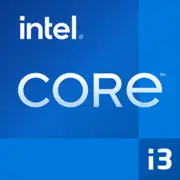Intel Core i3-6300

インテル Core i3-6300: 古くなったが依然として有用な予算向けプロセッサのレビュー (2025年)
はじめに
2015年のリリースからほぼ10年が経過した現在でも、インテル Core i3-6300はウルトラバジェットPCの人気選択肢です。しかし、2025年に購入する価値はあるのでしょうか?詳細を見てみましょう。
1. 主要仕様: Skylakeアーキテクチャとその遺産
アーキテクチャと製造プロセス
このプロセッサは、Skylake(インテル Coreの第6世代)に基づいたマイクロアーキテクチャで、14nmの製造プロセスを使用しています。DDR4に完全に移行した最初の世代であり、Broadwell世代と比較してIPC(クロック当たりの命令数)が5〜10%向上しました。しかし、2025年には、14nmはAMD Ryzen 5000/7000の7nmやインテル Alder Lake/Raptor Lakeの10nmと比較して古く感じられます。
性能
- 2コア / 4スレッド、基本クロック周波数は3.8 GHz(ターボブーストなし)。
- Geekbench 6: 1230(シングルコア)/ 2494(マルチコア)。
- L3キャッシュ: 4MB。
比較のために言うと、現代の予算プロセッサであるIntel Core i3-13100(4コア / 8スレッド、第12世代)は、Geekbench 6で約2200/8000を記録します。ギャップは大きいですが、i3-6300は基本的なタスクにはまだ対応可能です。
主な特長
- Intel HD Graphics 530 — GeForce GT 730レベルの統合グラフィックス(YouTube 1080pやDota 2を低設定でプレイ可能)。
- DirectX 12および4K出力のサポート(必要なポートを備えたマザーボードが必要)。
- TDP 51W — 現代の多くのプロセッサよりもエネルギー効率が高い。
2. 対応マザーボード: 中古市場での探し方
ソケットとチップセット
- ソケット LGA 1151(第一版、インテルの第8〜9世代と互換性なし!)。
- チップセット: H110, B150, H170, Z170。
推奨:
- オフィスPC向け: H110 — ポートは最小限ですが、安価(新しいマザーボードは稀、価格は40〜60ドル)。
- アップグレード向け: B150 — 4つのDDR4スロット、M.2 NVMeのサポート(アダプタ経由)。例: ASUS B150M-A。
- エンスージアスト向け: Z170 — メモリオーバークロック(ただしプロセッサ自体はオーバークロック不可)。
重要! LGA 1151用の新しいマザーボードはほとんど製造中止となっています。小規模な販売業者や中古品を探してください(新しいものは70ドルから)。
3. メモリ: DDR4のみ、ただし制約あり
- タイプ: DDR4-2133 MHz(公式)。DDR5はサポートしていません!
- 最大容量: 理論上は64GBまでですが、マザーボードは通常32GBに制限されています。
アドバイス: デュアルチャネルモード(8GB DDR4-2133の2モジュール)を使用すると、ゲームやレンダリングにおいて15〜20%の性能向上があります。
4. 電源ユニット: 最小コスト
- 電力計算:
- CPU: 51W。
- グラフィックボード(例: GTX 1650): 75W。
- その他のコンポーネント: 約50W。
合計: 51 + 75 + 50 = 176W。
推奨:
- ディスクリートグラフィックスなし: 300Wの電源ユニット(例: FSP Hyper 300)。
- グラフィックボードあり: 450〜500W(Corsair CX450、価格55ドル)。
重要! 電源ユニットにお金を節約しないでください — 古いモデルの低効率はコンポーネントを損傷する可能性があります。
5. メリットとデメリット: 2025年に誰に適しているか?
メリット:
- 価格: 新しいプロセッサは50〜70ドル(残り在庫)、中古は20〜30ドル。
- エネルギー効率: パッシブ冷却PCに最適。
- グラフィックス: HD 530は基本的なタスクを処理可能。
デメリット:
- 2コア: マルチタスクに制限あり(Chrome + Zoom + Word = 100%負荷)。
- 古いプラットフォーム: PCIe 4.0やUSB 3.2 Gen 2はなし。
- Windows 12未対応: Windows 10/11のみ(公式に)。
6. 使用シナリオ: どこで性能が足りるのか?
- オフィス作業: Word、Excel、5〜10のブラウザタブを開いた状態。
- マルチメディア: 4Kビデオの再生(ハードウェアデコード付き)、ストリーミング。
- 軽いゲーム: CS:GO(低設定で60 FPS)、Minecraft、GTA V(720p)。
- サーバー: NASやホームメディアサーバーは低いTDPのおかげで適しています。
実際の経験: Redditのユーザーはi3-6300を使用して、学習用の予算PCを組み立てました(SSD 256GB、8GB DDR4) — システムは5年間スムーズに動作しています。
7. 競合製品: 同類製品との比較
- Intel Pentium Gold G6400(2020年、2コア / 4スレッド):
- メリット: 新しいアーキテクチャ(Comet Lake)、価格70ドル。
- デメリット: シングルスレッドタスクでは劣る(Geekbench 6シングルコア〜1100)。
- AMD Ryzen 3 3200G(2019年、4コア / 4スレッド):
- メリット: Vega 8統合グラフィック(HD 530の2倍の性能)、価格90ドル。
- デメリット: TDPが高い(65W)、AM4マザーボードが必要。
結論: i3-6300は50ドル未満の場合にのみ競争力があります。それ以外の場合はRyzen 3 3200Gを選んだ方が良いでしょう。
8. ビルドに関するアドバイス: 失敗しない方法
1. SSDは必須: Kingston A400 240GB(25ドル)は、システムの起動時間を40秒(HDD)から10秒まで短縮します。
2. 冷却: ボックスクーラーで十分ですが、静音のためにはDeepcool GAMMAXX 400(20ドル)を選ぶと良いでしょう。
3. アップグレード: 計画を立てないでください — LGA 1151ソケットは終了しています。「そのまま」でPCを組み立ててください。
4. BIOSを確認: 中古のマザーボードを購入する場合は、互換性のためにファームウェアを更新してください。
9. 結論: 2025年に誰にi3-6300が適しているか?
このプロセッサは以下の2つのケースのみで検討すべきです:
1. 超低予算のビルド(200ドル以下)でオフィス、学習、またはサーバー目的。
2. 古いPCのアップグレード(すでにLGA 1151マザーボードを所有している場合)。
代替案: 100〜150ドルで、将来に備えたAMD Ryzen 5 5500(6コア / 12スレッド)システムが組めます。しかし、予算が厳しく制限されている場合には、i3-6300がまだ役に立つでしょう。
結論: 2025年のインテル Core i3-6300は、経済的ではあるが要求が厳しくないユーザー向けの選択です。彼の時代は過ぎ去ったものの、ウルトラバジェットPCのニーズは依然として存在しています。
基本
CPUの仕様
メモリ仕様
GPUの仕様
その他
ベンチマーク
他のCPUとの比較
ソーシャルメディアで共有する
または当サイトへのリンクを追加
<a href="https://cputronic.com/ja/cpu/intel-core-i3-6300" target="_blank">Intel Core i3-6300</a>